National symbols of Belgium
National symbols of Belgium are the symbols used to represent the Kingdom of Belgium. Article 193 of the Belgian Constitution is dedicated to specifying the national flag, colours, coat of arms, and motto. It says the following: "The Belgian nation takes red, yellow and black as colours, and as state coat of arms the Belgian lion with the motto Unity makes strength."[1]

National day
The national holiday of Belgium, Belgian National Day, is commemorated annually on 21 July,[2][3] but even though it is official, it is usually not considered a national symbol. The Flemish holiday is celebrated on 11 July,[3][4] the Walloon holiday is celebrated on the third Sunday in September,[3][5] the French-speaking Community's holiday is celebrated on 27 September, the German-speaking Community's holiday is celebrated on 5 November[3][6] and the Brussels holiday is celebrated on 8 May.[3]
List of official national symbols
| Symbol | Image | Notes | |
|---|---|---|---|
| Flag | Flag of Belgium |  |
[7] |
| Coat of arms | Coat of arms of Belgium |  |
[8][9] The lesser coat of arms is the coat of arms used by the Belgian federal government and its official sites, on passports and on embassies. |
| National anthem | La Brabançonne | La Brabançonne
|
[10][11] |
| National motto | Unity Makes Strength |  |
[8][9] The motto is official in all three official languages of Belgium (Dutch: Eendracht Maakt Macht; French: L'Union Fait La Force; German: Einigkeit Macht Stark). The French version is the most commonly used. |
List of official symbols of the Belgian communities and regions
| Symbol | Image | Notes | |
|---|---|---|---|
| Flag | Flag of the Brussels-Capital Region | 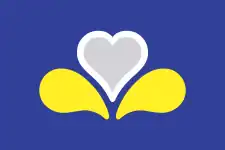 |
[12][13][14] |
| Emblem | Regional emblem of Brussels |  |
After the flag changed in 2015 the emblem remained in use. It can be seen on the logo of Brussels parliament. |
| Coat of arms | Coat of arms of the city of Brussels | 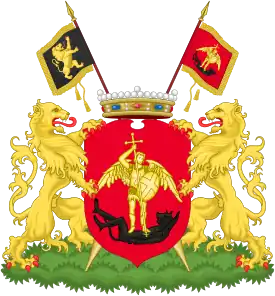 |
[15] |
| Flower | De facto: Iris | .jpg.webp) |
[16] The iris is a de facto symbol of Brussels as it is depicted on the flag and emblem. Irises have been a cultural icon of Brussels for a relatively long time, as many irises natively grow in the Brussels area. |
| Flag | Flag of Flanders |  |
[13][17][18] |
| Coat of arms | Coat of arms of Flanders | 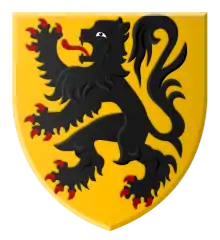 |
[4] |
| Anthem | De Vlaamse Leeuw
(English: The Flemish Lion) |
De Vlaamse Leeuw
|
[4] |
| Animal | De facto: The Flemish lion | The black Flemish lion can be seen on the flag, coat of arms and is mentioned in the anthem and is used by the Flemish government as well. It could be seen as the de facto animal of Flanders. The novel The Lion of Flanders is often considered the national epic of Flanders. | |
| Flag | Flag of Wallonia |  |
[13][5][19] |
| Coat of arms | Coat of arms of Wallonia | 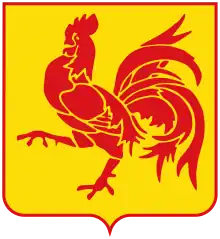 |
[5][19] |
| Anthem | Le Chant des Wallons
(English: The Song of the Walloons) |
Le Chant des Wallons
|
[5] |
| Animal | De facto: The Walloon rooster | Just like the Flemish lion in Flanders, the so called coq hardi can be seen on the flag and coat of arms. It is widely known as de facto animal of Wallonia. | |
| Flower | La gaillarde
(Blanket flower) |
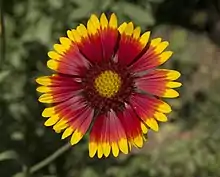 |
[5][20] The gaillarde (blanket flower) was made an official symbol of Wallonia in 1914, because it would have served as a rallying sign for the Liège patriots in the Liège revolution and the flower's colours are the same as the flag of Wallonia. |
| Flag | Flag of the German-speaking Community of Belgium |  |
[13] |
| Coat of arms | Coat of arms of the German-speaking Community of Belgium |  |
[21][6] The animal on the coat of arms of the German-speaking Community is a red heraldic lion, which symbolizes the duchies of Limburg and Luxembourg. The nine flowers are nine gentiana-flowers, who grow in the High Fens (German: Hohes Venn), and they symbolize the nine German-speaking municipalities of Belgium. The crown symbolizes the affiliation to the Kingdom of Belgium. |
Unofficial symbols

The lion, especially the Leo Belgicus (Latin for "Belgian Lion") has been used as a heraldic animal to represent the Benelux for centuries. A heraldic lion can be seen on the Belgian coat of arms and can be seen as the countries de facto national animal. Moules-frites is often considered the unofficial national dish of Belgium.[22][23][24] The red poppy (papaver rhoeas) is often considered the national unofficial national flower of Belgium.[25][26][27] Other symbols of Belgium might include Manneken Pis, the Atomium, Belgian waffles, and Belgian fries, which were invented in Belgium.
 Moules-frites
Moules-frites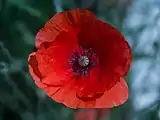 Red poppy
Red poppy The Atomium
The Atomium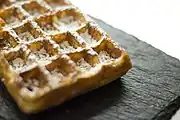 Brussels waffle
Brussels waffle Liège waffle
Liège waffle
References
- "DE BELGISCHE GRONDWET". www.senate.be. Retrieved 2020-03-18.
- "21 July: Belgium's National Day!". visit.brussels. Retrieved 2020-03-19.
- "Nationale Feestdag en feestdagen gemeenschappen en gewesten". Belgium.be (in Dutch). 2012-09-25. Retrieved 2020-03-19.
- "Dossier: Vlaamse Symbolen". www.vlaamsparlement.be (in Flemish). Parlement Vlaams. Retrieved 2020-03-19.
- "Symboles". Connaître la Wallonie. Retrieved 2020-03-19.
- "Wappen und Fahne". www.ostbelgienlive.be. Retrieved 2020-03-19.
- "Flag of Belgium". Encyclopedia Britannica. Retrieved 2020-04-21.
- "Symbolen". The Belgian Monarchy (in Dutch). Retrieved 2020-03-19.
- "Wapenschild en leus". Belgium.be (in Dutch). 2012-09-25. Retrieved 2020-03-19.
- "What are the lyrics to the national anthem of Belgium, 'La Brabançonne'?". Classic FM. Retrieved 2020-03-19.
- "Hymnes". Belgium.be (in Dutch). 2015-09-02. Retrieved 2020-03-19.
- "Region of Brussels-Capital (Belgium)". www.crwflags.com. Retrieved 2020-03-19.
- "Vlaggen van België". Belgium.be (in Dutch). 2013-10-02. Retrieved 2020-03-19.
- "Gewest gaat voor nieuwe vlag met hartjeslogo". www.bruzz.be (in Dutch). Retrieved 2020-03-19.
- "Brussel - Coat of arms of Brussels/Wapen van Brussel/Blason de Bruxelles". www.heraldry-wiki.com. Retrieved 2020-03-19.
- "De iris". Belgische volksverhalen (in Dutch). August 2015. Retrieved 2020-03-19.
- Istasse, Cédric (July 10, 2014). "Histoire et mémoire(s) : de la bataille des Éperons d'or du 11 juillet 1302 à la fête de la Communauté flamande" (PDF). Les @nalyses du CRISP en Ligne (in French). Retrieved 2020-03-21.
- "Flanders (Belgium)". fotw.info. Retrieved 2020-03-19.
- "Drapeau". Connaître la Wallonie. Retrieved 2020-03-19.
- "Fleur". Connaître la Wallonie. Retrieved 2020-03-19.
- "Wappen und Logo". www.pdg.be (in German). Retrieved 2020-03-19.
- Schaap, Esther (2018-04-30). "5 redenen om te kamperen in België". Suncamp holidays Blog (in Dutch). Retrieved 2020-03-18.
- "L'origine des moules-frites". Léon de Bruxelles. Retrieved 2020-03-19.
- Krause, Suzanne (2015-06-20). "Moules-Frites: Eine kleine Kulturgeschichte des belgischen Nationalgerichts". Deutschlandfunk (in German). Retrieved 2020-03-19.
- "Blumen von Belgien – Roter Mohn". Tipps Gärtner (in German). Retrieved 2020-03-18.
- "What Is The National Flower of Belgium?". WhatsAnswer. 2018-01-21. Retrieved 2020-03-19.
- "National, Native and Popular Flower of Belgium". The Flower Expert. Retrieved 2020-03-19.